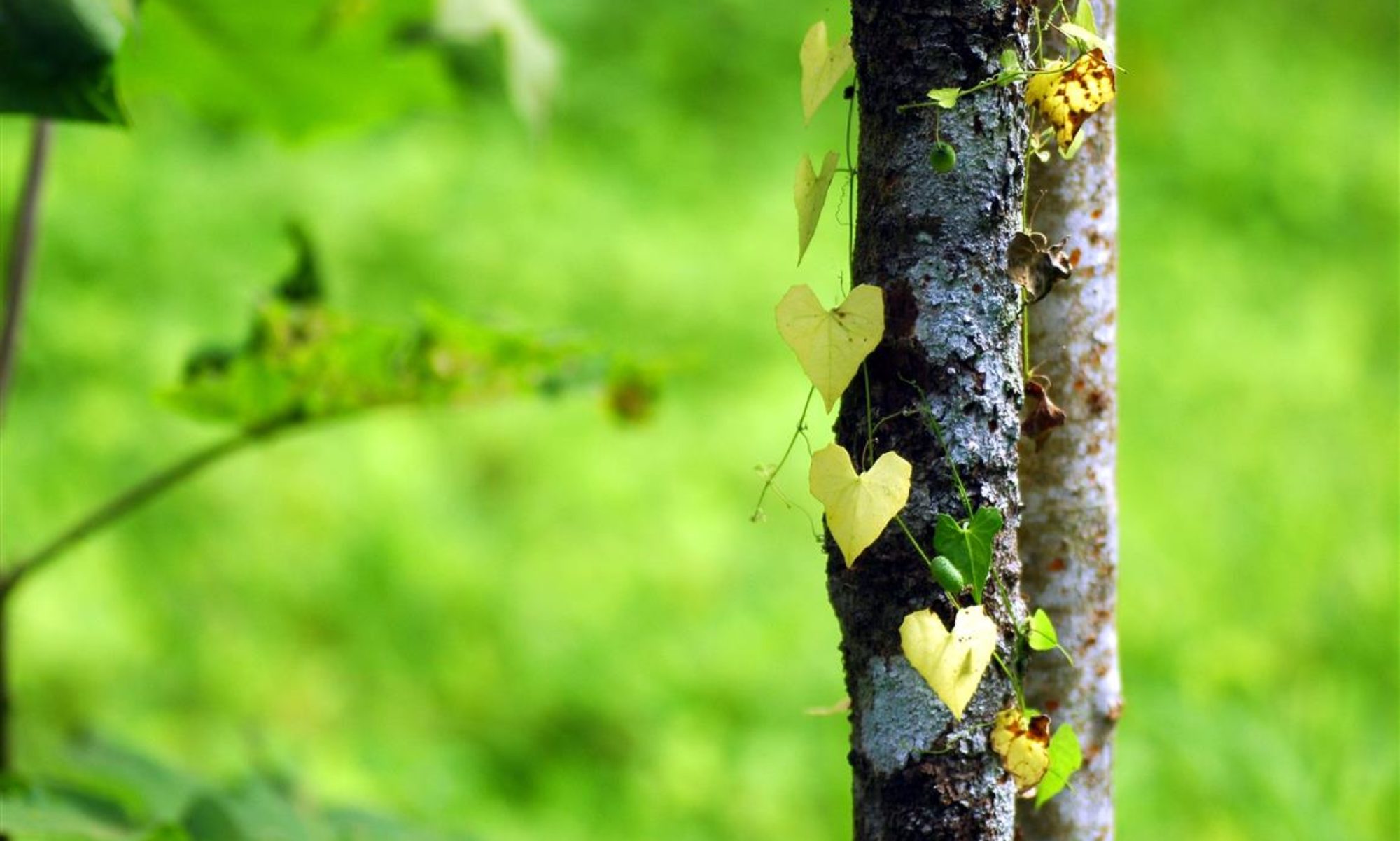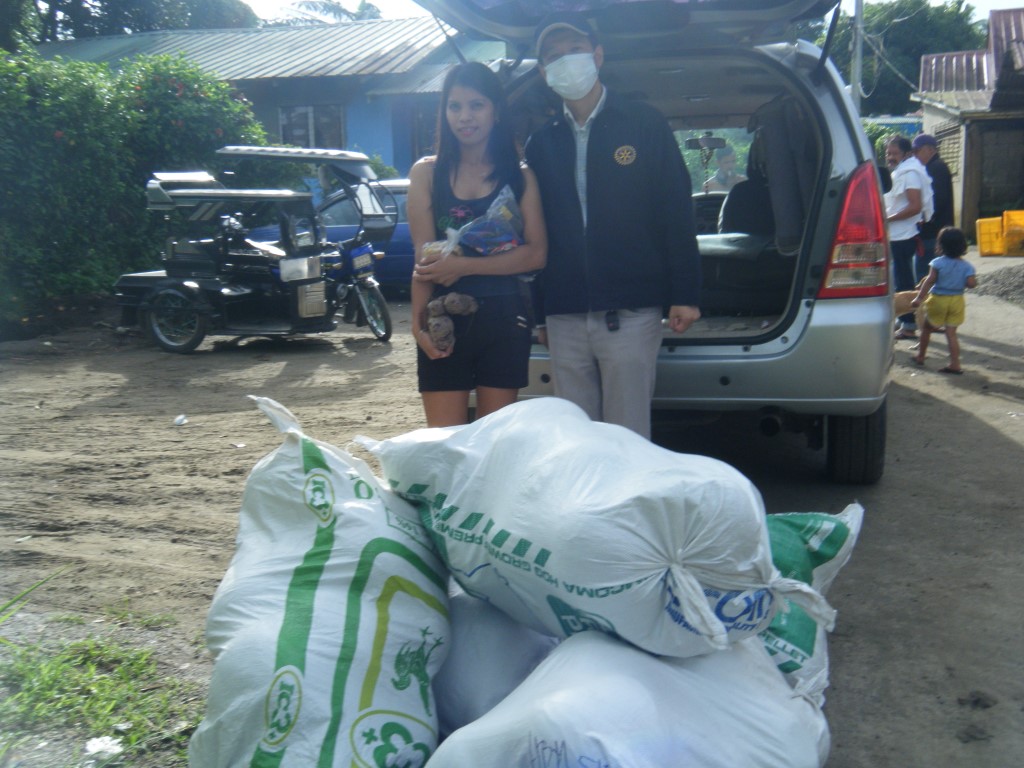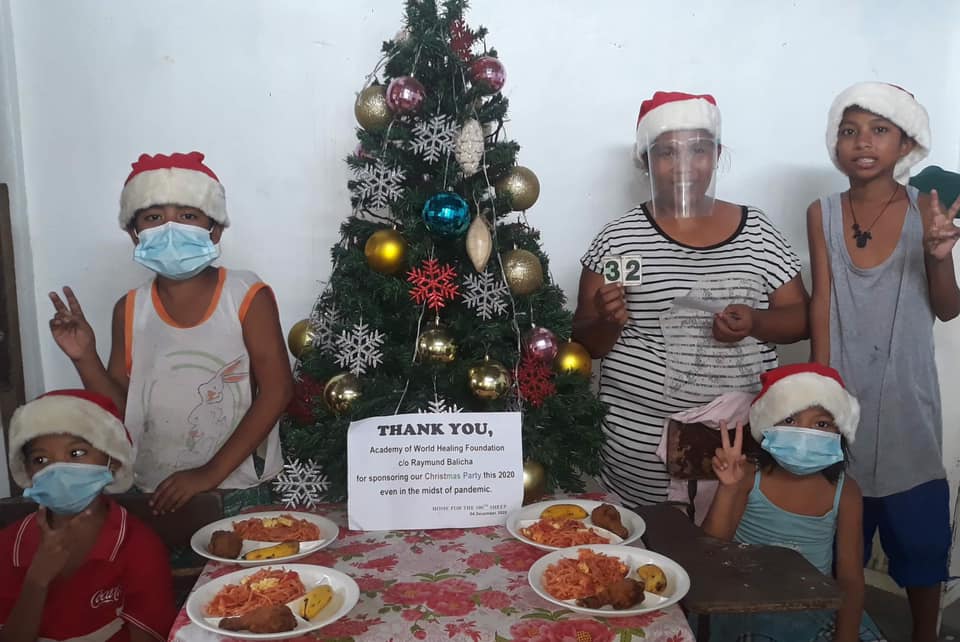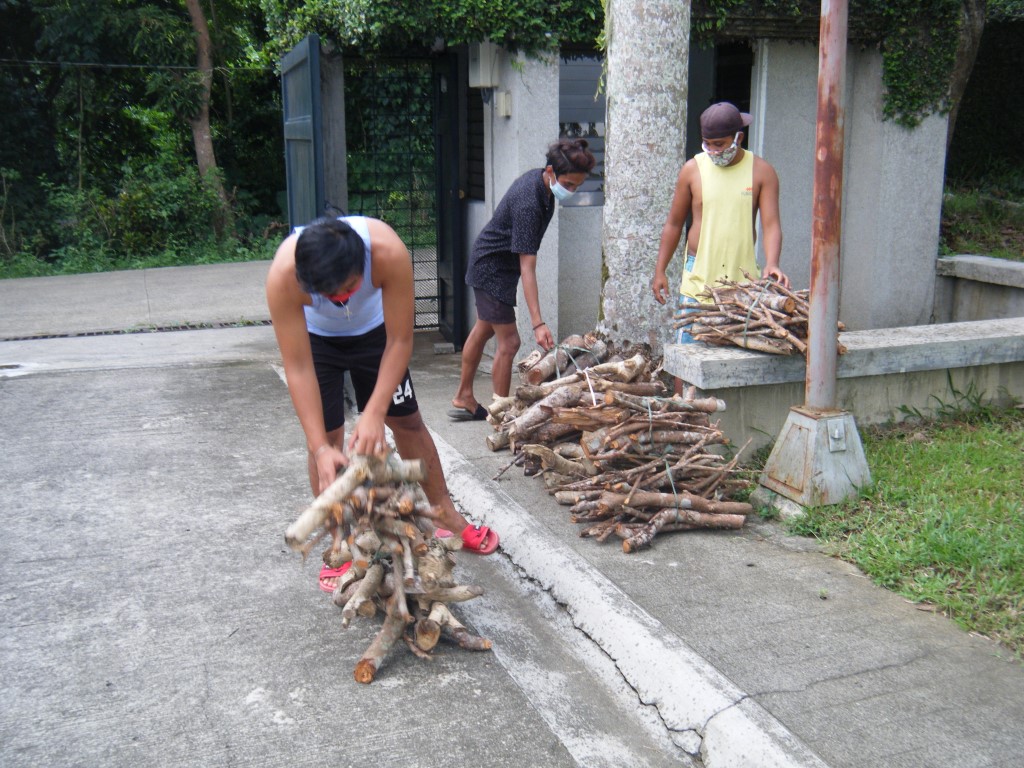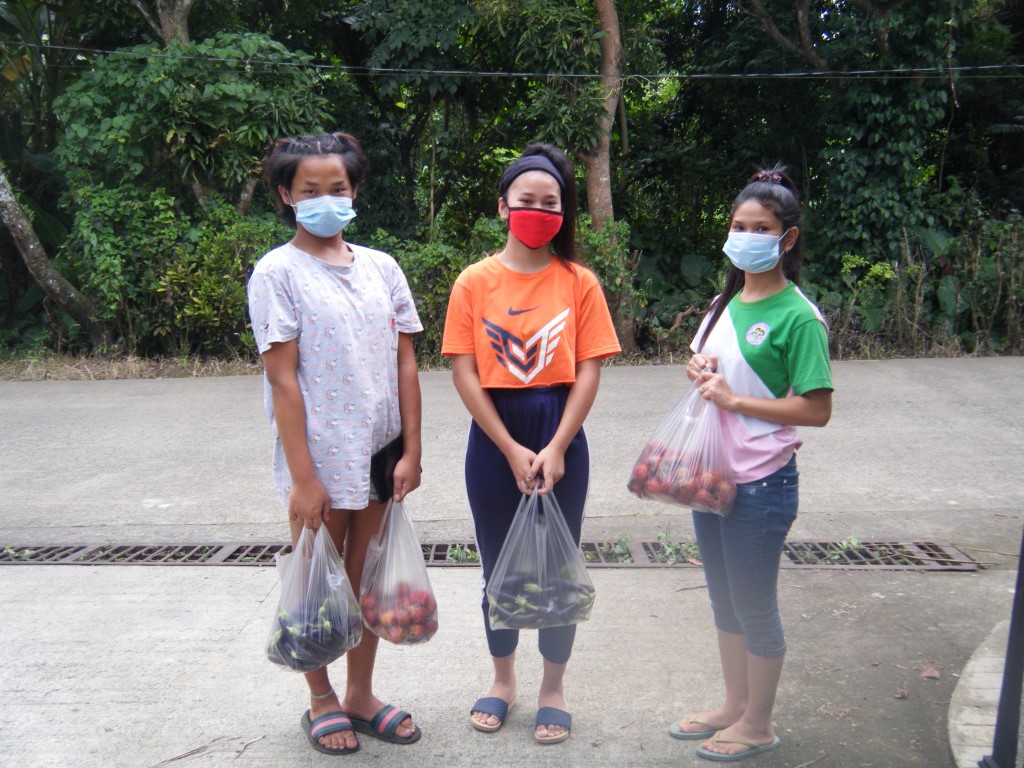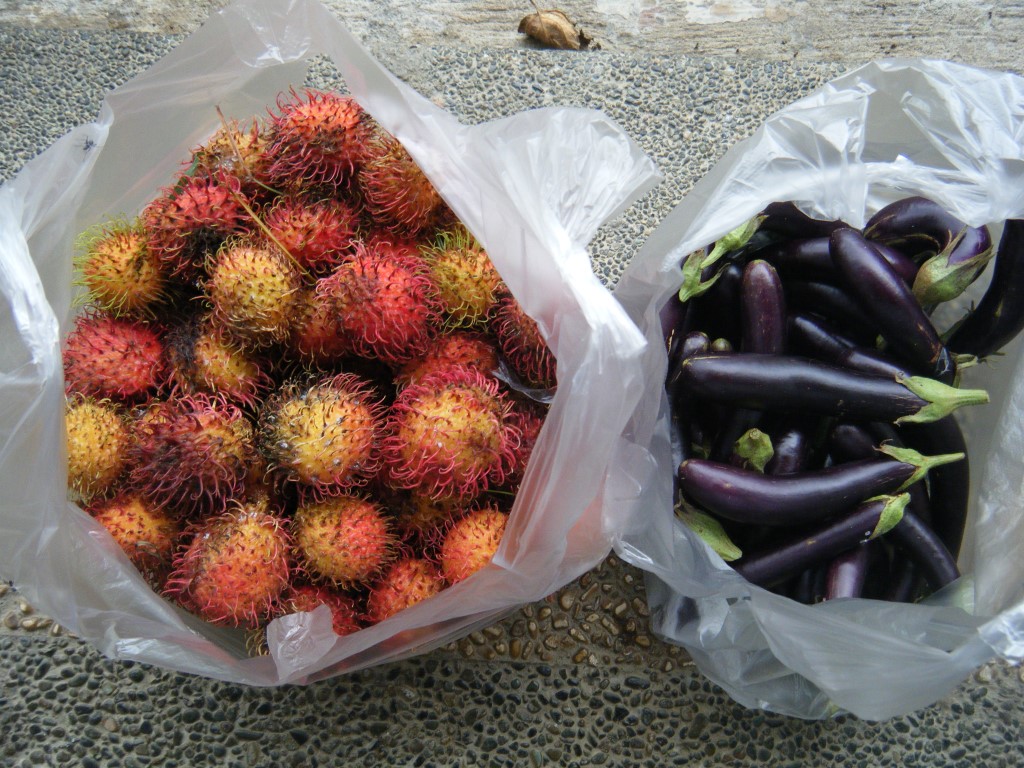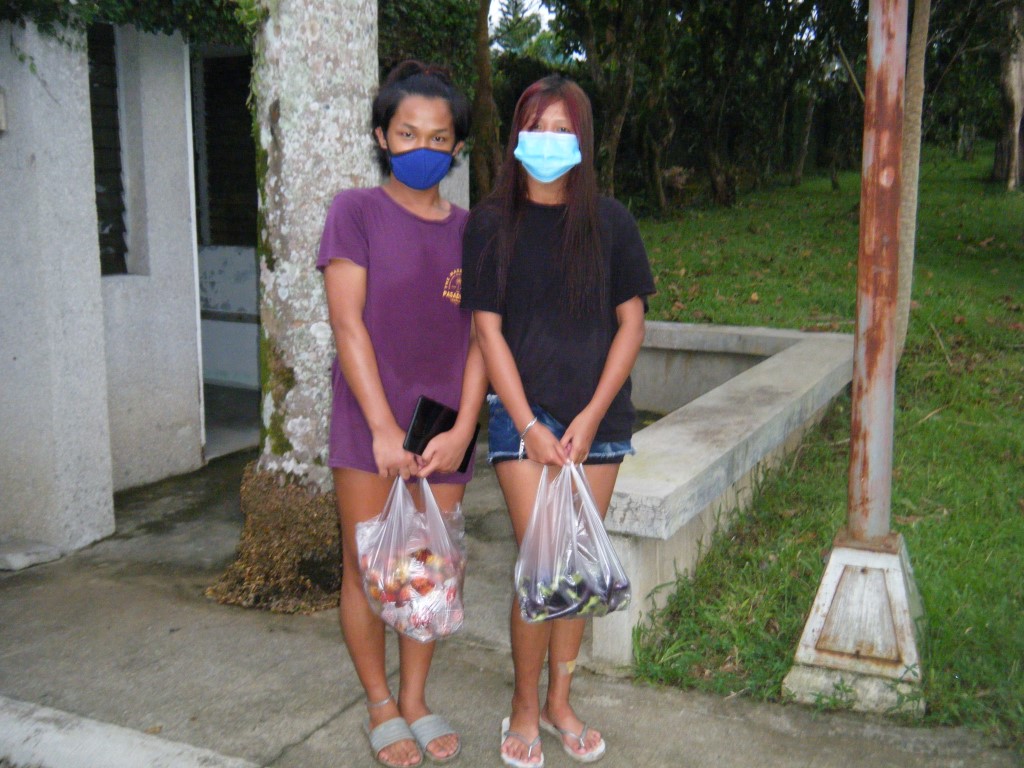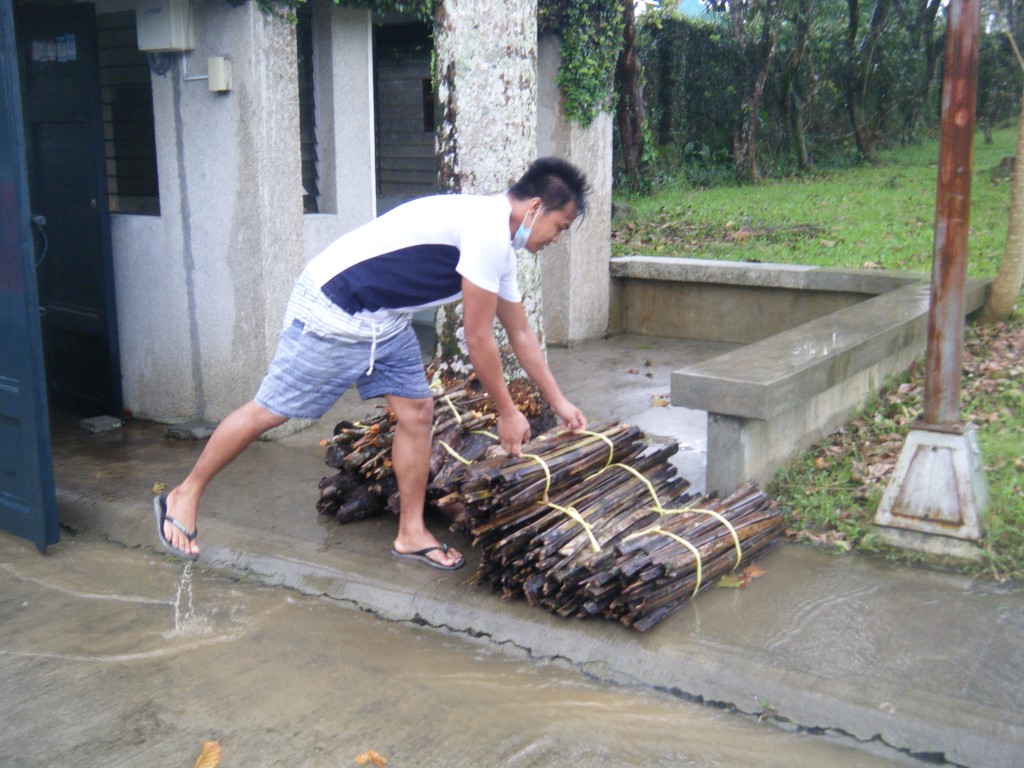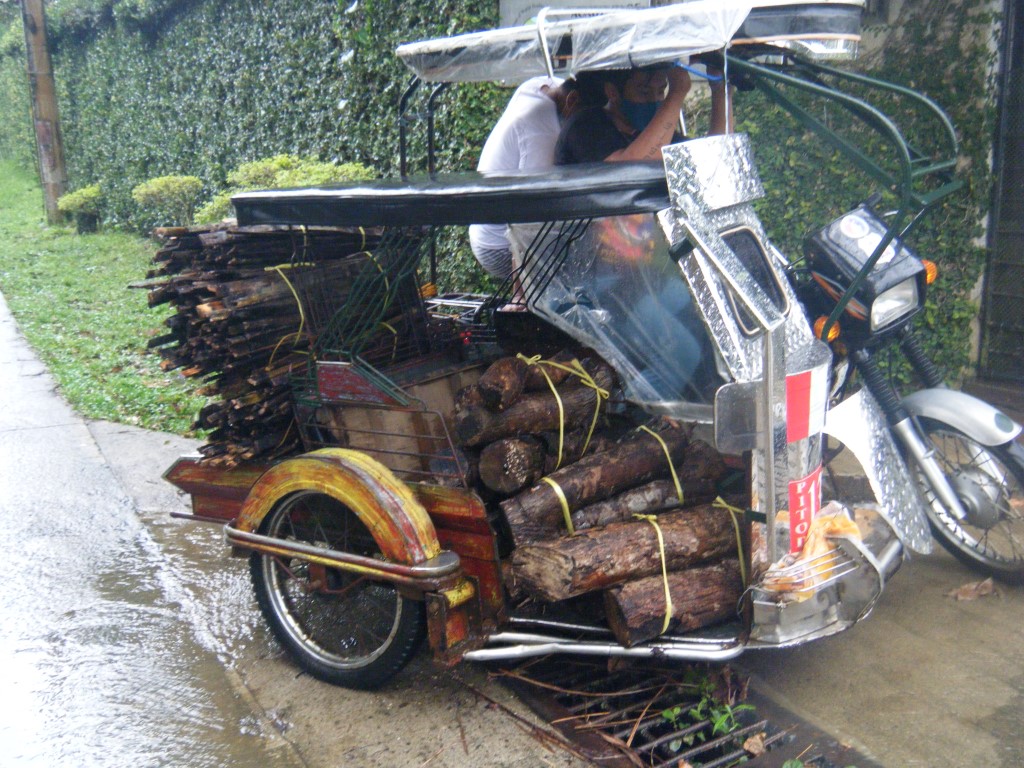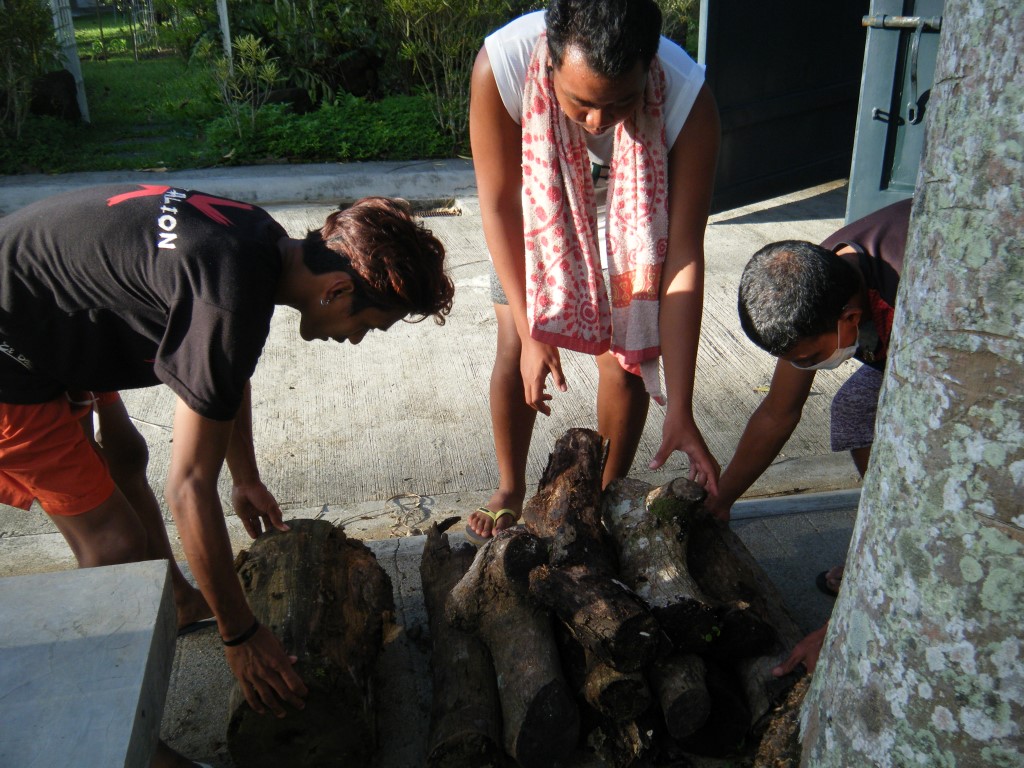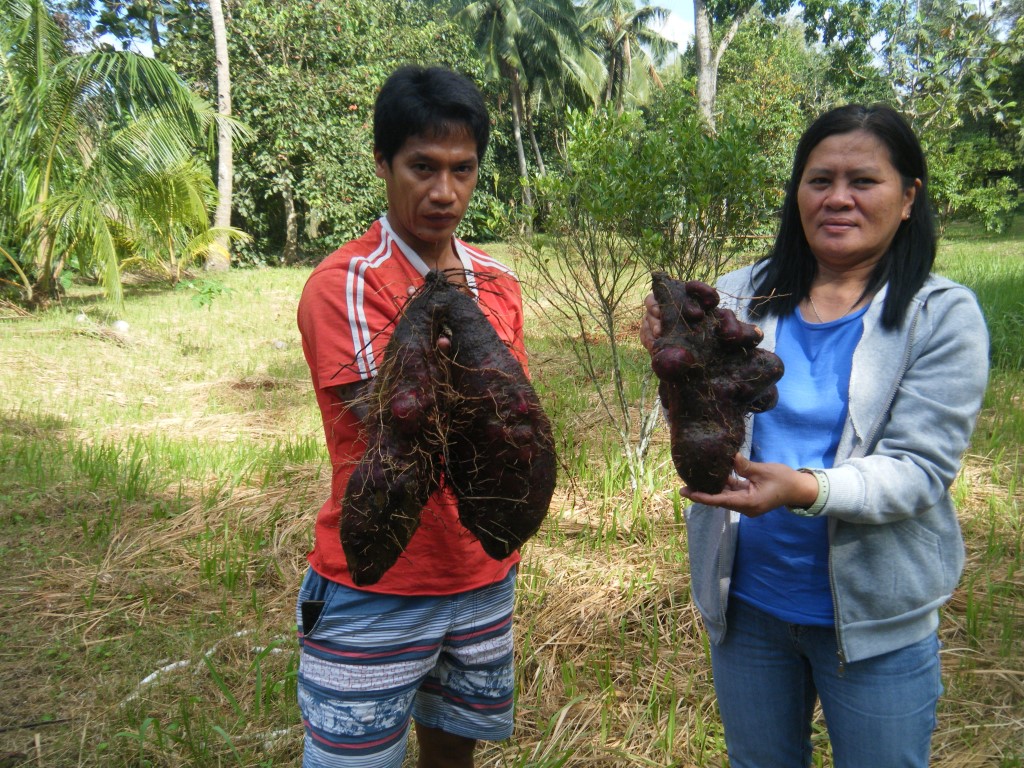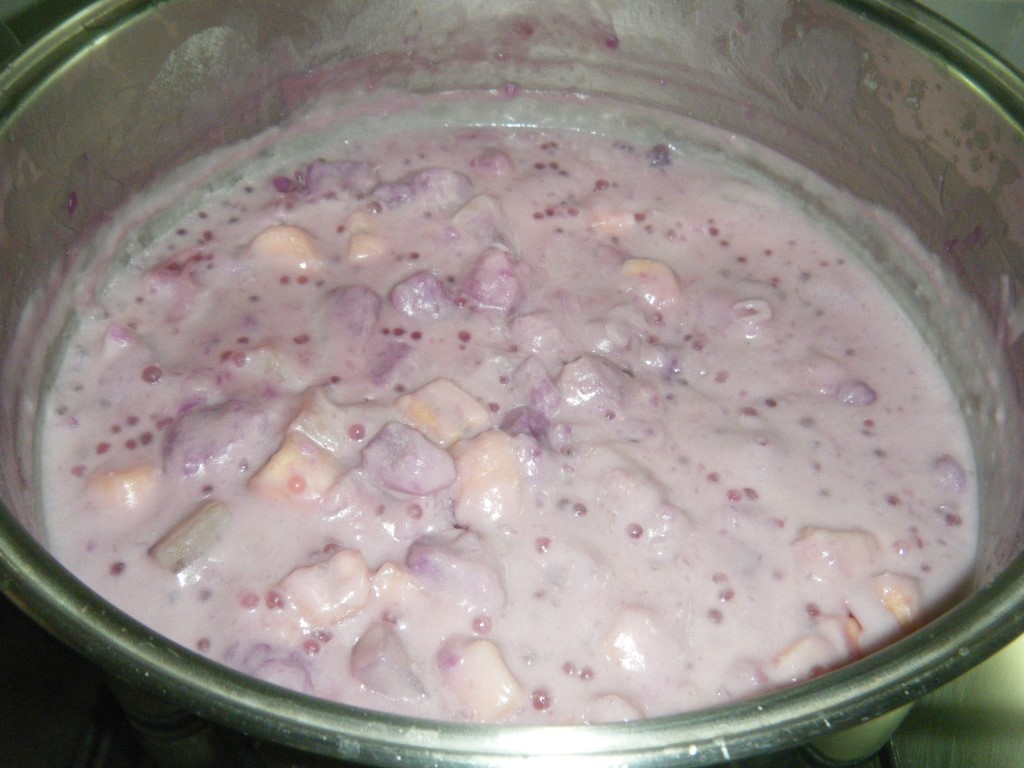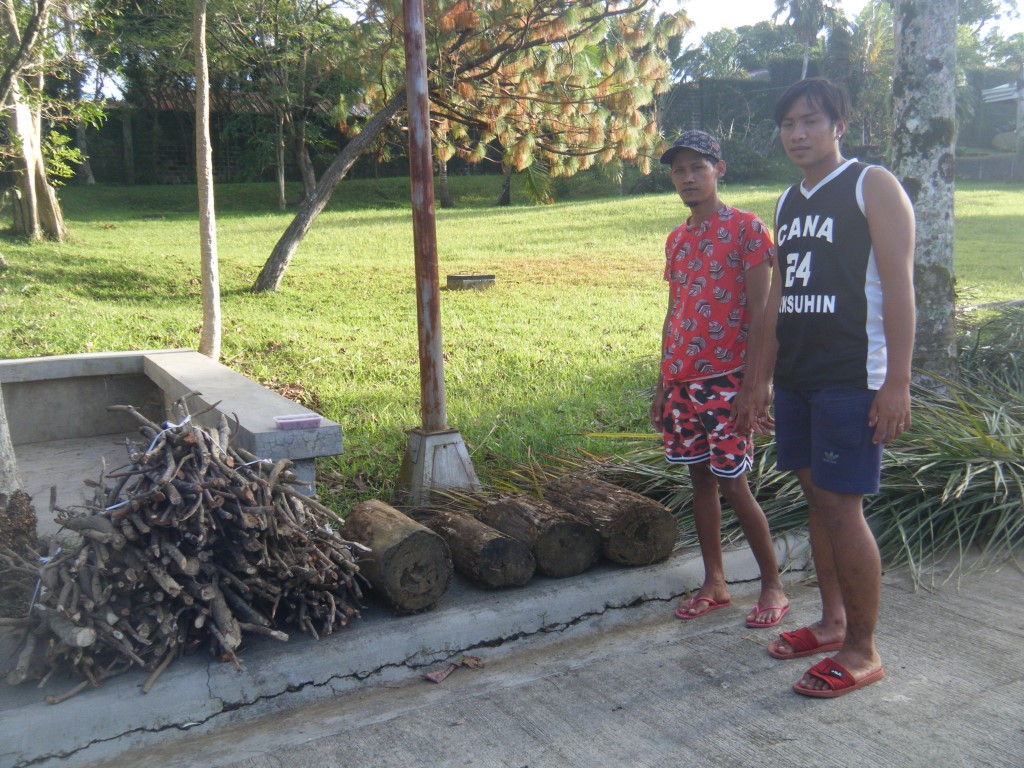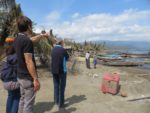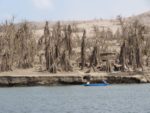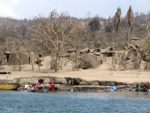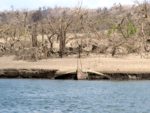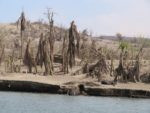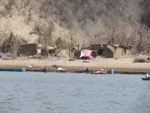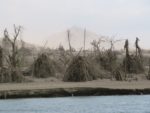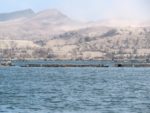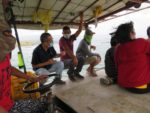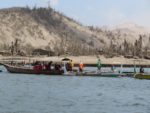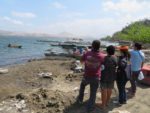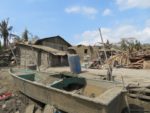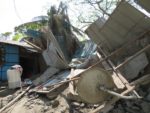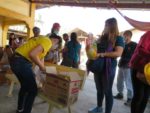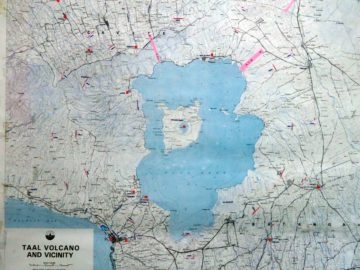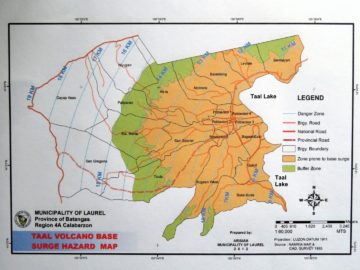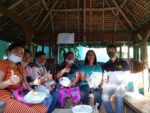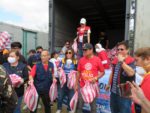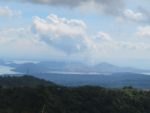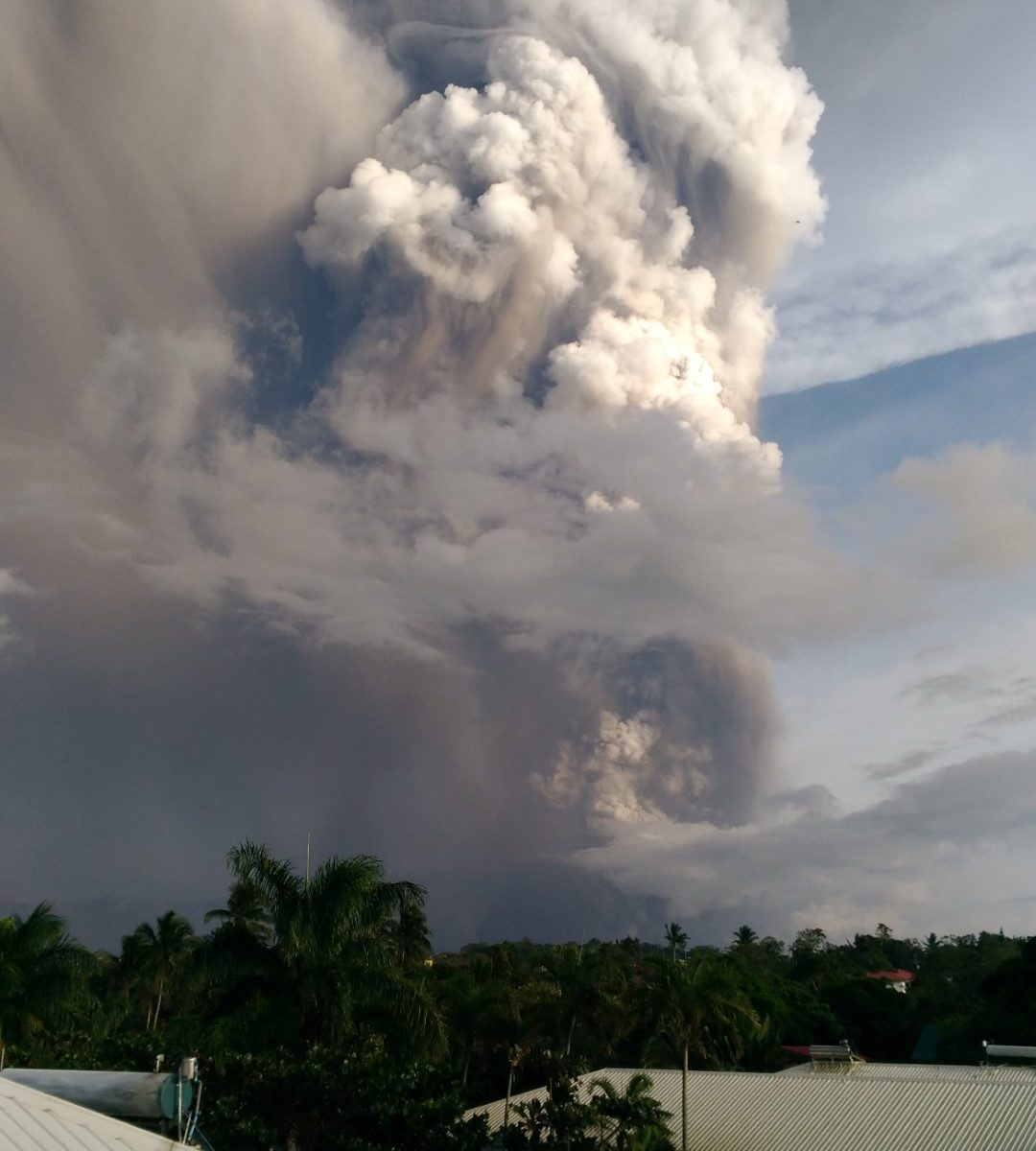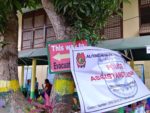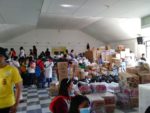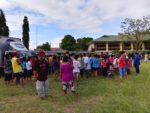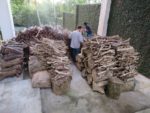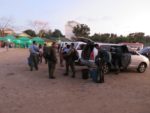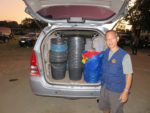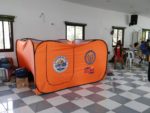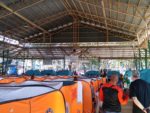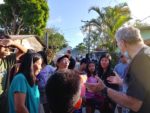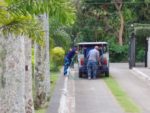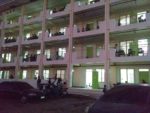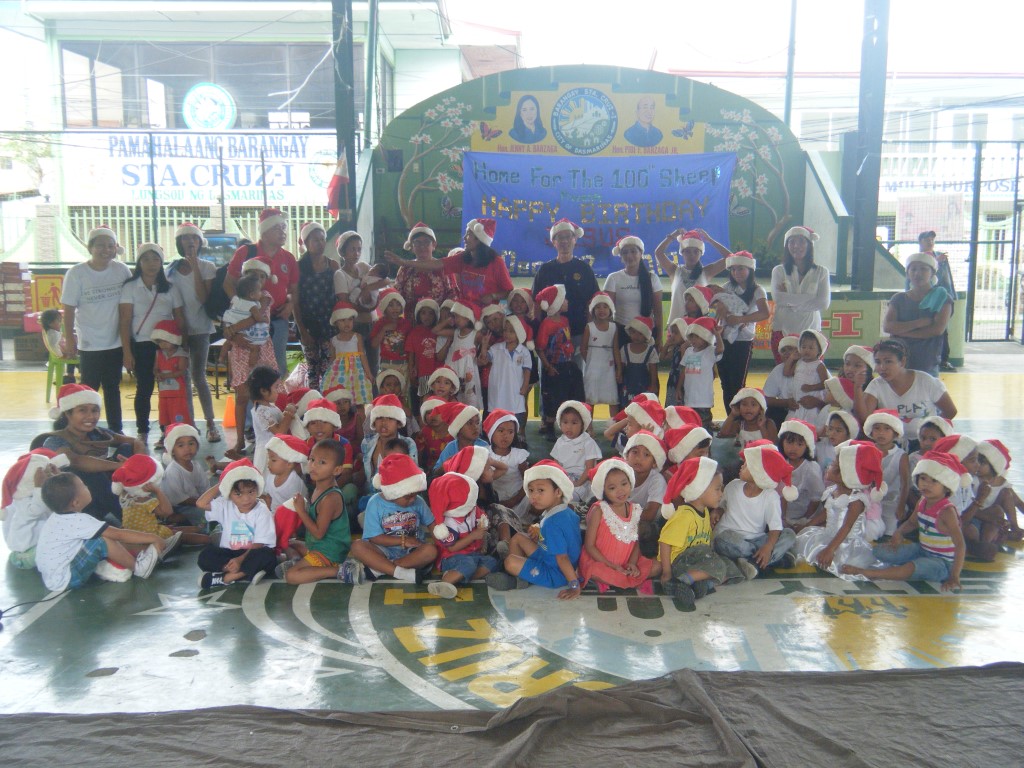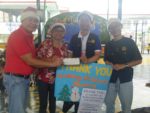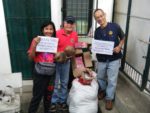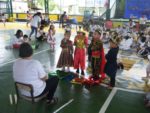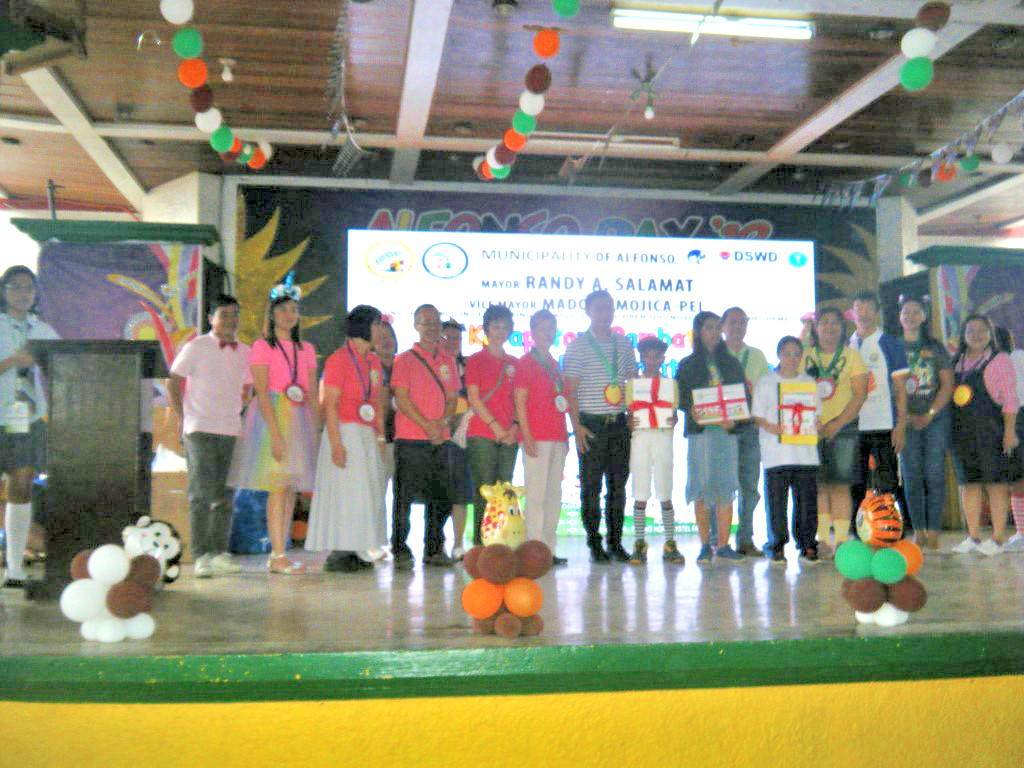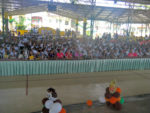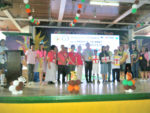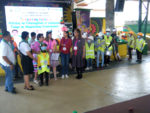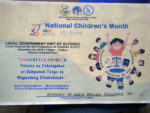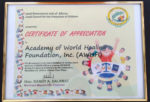AWH has granted Carlos Alcobendas, one of the students from Camp Hope (nearby squatter camp) who is also supported by RIMM (Rotary International Multinational-Manila), two weeks of free Wi-Fi usage at the Annex building for his online class on Monday to Thursday (1PM – 4PM).
He is in Grade 11 at the Luksuhin National High School taking up a Technical Vocational Livelihood (TVL) course major in Baking. His father is a taho (tofu) vendor and unable to sufficiently support his study needs.
Due to the Covid-19 pandemic students are taking module and online classes since last year. He said that it is essential to complete the class.
Indigent Support
On December 15, 2020, AWH distributed 17 sacks filled with 272 pieces of brown coconuts and homegrown ube yams to the three nearby indigent camps (Usting 1, 2 and Camp Hope).
The indigent settlers said that they will utilize the coconut milk to make popular Filipino rice desserts and other meals this coming Christmas and New Year season.
They said that the cost of coconut milk increases during the holiday season due to high demand and this provision was highly appreciated.
Update on January 14, 2021
AWH delivered sacks of brown coconuts and bananas to Usting 1 & 2 in Alfonso.
The indigent residents said they enjoy the tasty coconut milk which is added to their rice and vegetables meals.
AWH harvested another bunch of bananas and decided to share them to the 2 camps.
The children also enjoyed the bread we brought.
Update on January 29, 2021
Several chunks of logs were picked up by 3 residents from nearby indigent camp who are selling taho (tofu) for their livelihood. The firewood will be used to cook taho as their primary source of income to sustain the needs of their families.
Update on March 5, 2021
AWH assisted the taho (tofu) vendors in Camp Hope with firewoods.
The pieces of logs they picked up on March 5, 2021 are perfectly dried firewood logs were picked up to cook soybeans for taho making.
It was much appreciated especially during the Covid-10 pandemic.
Update on May 14, 2021
Three residents of Camp Hope (nearby indigent settlers) visited again and picked up bundles of large firewood.
The firewood will be used for cooking soybean to make taho (tofu). In this pandemic they use firewood even for cooking their meals since the LPG gas cost has soared.
Their activities for work were limited when the strictest Enhanced Community Quarantine (ECQ) status was declared last month and made no income.






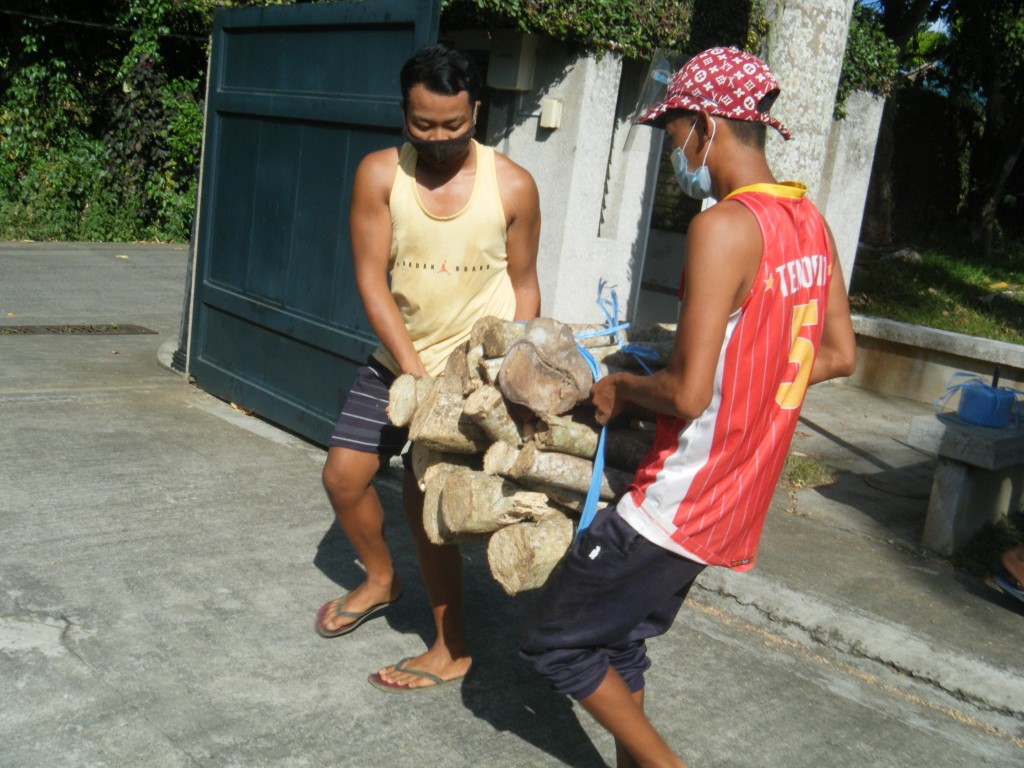

Home For The 100th Sheep Christmas Party
Because of the community quarantine restrictions in pandemic time, AWH funded Home for the 100th Sheep foundation by wire remittance this year.
On December 4, 2020, a Christmas feeding program for its indigent pupils was held in the migrated squatter area. Pasta and fried chicken were cooked by 33 volunteers and the total of 191 children were served.
Kaloi and Edna were very grateful for the continued support of AWH even during the Covid-19 pandemic.
Cagayan Relief Operation
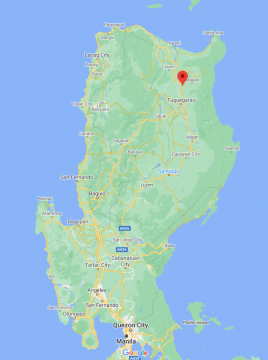 On 11 November 2020, Typhoon Vamco/Ulysses struck Luzon bringing destructive winds and heavy rainfall.
On 11 November 2020, Typhoon Vamco/Ulysses struck Luzon bringing destructive winds and heavy rainfall.
According to the Office of Civil Defense officials, more than 151,600 families, composed of 583,493 individuals, were also affected by Typhoon Ulysses in the Cagayan Valley region, leaving more than 2,200 families in evacuation centers.
The typhoon likewise left millions of damages in the region’s agriculture and infrastructure.
Based on initial reports from the Department of Agriculture, the typhoon left 73.788 million peso damages in the region’s agriculture sector. The Department of Public Works and Highways reported damage of P44.955 million in infrastructure.
In the morning of December 6, 2020, Gina of DSWD (Department of Social Welfare Development) Alfonso picked up P20,000 Cagayan relief fund designated as a part of quarterly donations that have been made by AWH at its headquarters before heading to Cagayan Province in North Luzon.
The fund was planned to provide cash assistance of P500 each to the affected families in Cagayan whose homes were devastated from the recent Typhoon Ulysses causing massive flooding in the province.
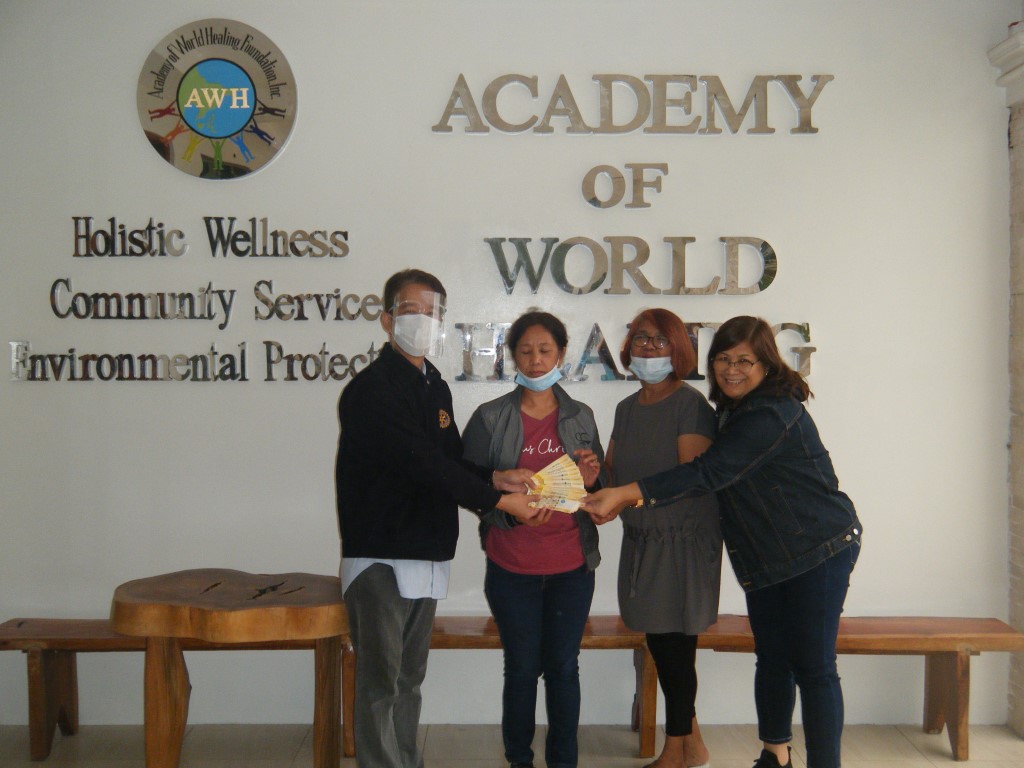
Joining Gina on the long trip were Jun of Army Reserve Command (ARESCOM)and a honorary member of Rotary Club of Multinational Manila, Alfonso Municipal Engineer Tibayan, Municipal Councilor Carol and other municipal personnels.
The relief mission to Cagayan was organized by the Office of Mayor Randy, DSWD and other private donors from Alfonso.
Among many items for distribution included food and school supplies, hygiene kits, blankets, sleeping mats etc.
The DSWD team went to an impoverished Brgy. Amulong Ligsa Salona in Cagayan wherein 40 families were given P500 cash assistance from AWH.
The Municipality of Alfonso donated 750 bags of rice, assorted canned goods, hygiene kits, 100 pieces of blankets and sleeping mats (banig) to the local government of the Province of Cagayan.
Indigent Support
AWH’s neighbor indigent village “Camp Hope” visited AWH and received bundles of firewood for cooking Taho (Tofu), which is their livelihood in selling them.
AWH also shared ‘Rambutan’ fruits that are in harvesting season and eggplants from its garden with the people in Camp Hope and the other two indigent villages.
Update on October 16, 2020
Continued indigent support for Camp Hope residents with provision of firewood bundles.

Update on November 5, 2020
Firewood to cook taho (tofu) is essential for their livelihood. Camp Hope residents received another bundles donated by AWH.
Update on November 14, 2020
Another contribution of firewood logs to Camp Hope residents.
Update on November 26, 2020
Another donation of firewoods to taho (tofu) vendors in the nearby indigent squatter Camp Hope.
AWH also shared ube ginataan for their children made from our homegrown ube yams.
Update on December 12, 2020
It requires constant support in donation of firewoods especially in Pandemic time.




Update on December 28, 2020
Another donation of firewood bundles to the taho vendors from Camp Hope.




2020 Laurel Evacuation Sites
On January 26, 2020, as the alert level for a volcanic eruption was lowered from 4 to 3, many evacuees went home except for residents within a 7km radius from the volcano wherever areas had been heavily damaged.
As of February 1, 2020, approximately 1,700 individuals (357 families) from the affected Laurel areas were relocated from the upland evacuation sites to three evacuation centers in Laurel, Batangas. AWH staff along with DSWD (Department of Social Welfare Development) Alfonso staff visited the main evacuation center in Laurel and discussed with Mayor Joan Amo long-term assistance needed by evacuees who can not return home.
Initially AWH thought of raising funds for the purchase of farm land for those who permanently lost homes near the lake. However, the mayor cautioned that fishermen are attached to the lake and their fishery livelihood and would return there even if not permitted.
According to the statistics presented by the mayor’s office of Laurel, about 110 houses were totally destroyed from heavy, wet ash fall. Mayor Joan stated that the municipality plans to purchase land just at the outskirt of the Tall Lake easement and provide more ash/storm resistant houses each of which would cost P50,000 to P60,000. AWH will try to assist as much as possible with helping to provide such affordable housing.
Our team then proceeded to the fishermen’s village in heavily damaged barangay Buso Buso, Laurel that is located across the lake from and within 7 miles of Volcano Island. Here the team, in cooperation with DSWD, distributed food, water, mosquito nets, etc. Volcano island itself was blanketed with a thick layer of ash that had destroyed virtually all houses and boats of its over 1,000 residents. They all had escaped from the island safely, being forwarned by an earthquake a few hours before the actual wet ash eruption.
2020 Taal Volcano Evacuation (Updated)
In the late afternoon of Sunday January 12, 2020, Taal Volcano, located on a small island in the middle of Taal Lake, erupted in a 10-15 km (6.2-9.3 mi) high steam-laden ash column, along with lightning and thunder caused by the interaction of the ash particles. Within a short time the low-lying areas surrounding the lake were covered with largely wet ash which inundated villages there as well as smothered the crops. No human lives were lost, but death and suffering of livestock and wildlife was evident everywhere. For example, on Volcano Island itself, a tourist spot for many years despite the history of earlier violent eruptions, only 300 of the approximately 3,000 donkeys were able to be rescued while the remainder died a slow and agonizing death.
Immediately after the vertical ash column eruption, the Alert Level was raised from then already 3 to 4 which means that an immediate explosive eruption may be imminent. This triggered immediate evacuation in the next couple of days in excess of 100,000 people for a distance of 14 km from the volcano’s epicenter, and may be raised to 17km if such an outbreak occurs. As indicated on the map Taal Volcano and Vicinity, which can be used as a reference guide, AWH is located within the 14 – 17 km zone and the Aguinaldo Highway Ridge Road through Tagaytay that provides access from Manila is located within the 14 km zone.
The 14 km circular evacuation zone is based on base surges, their buffer zones and on ballistic projectiles gleaned from updated information of historical eruptions of 1754, 1911, and 1964. Base surges are clouds of hot gases, ash, and rocks traveling horizontally at speeds in excess of 80 km per hour. Ballistic projectiles are large volcanic fragments thrown from the vents during explosions. Since a major portion of the municipality of Laurel in the province of Batangas is located within the most affected watersheds leading downslope to the ocean, their base surge buffer zones extended up to 14 km and were part of the “lock-down” evacuation that occurred in these areas. Unlike the eruptions on the Big Island of Hawaii, fissures caused by earthquakes related to volcanic activity are not expended to produce lava flows.
AWH was fortunate as it only received a very light but fertile ash layer because of the prevailing SW winds, the afternoon upslope winds, as well as the high elevation winds which blew the upper vertical ash column easterly towards Manila. The main concern for those affected by the ash but not living around or downslope of the lake was the unhealthy ash and sulfur dioxide-laden air, and breathing masks were in high demand.
At AWH the power was cut by the next day with the power outage lasting four days while most of the stores in the area also shut down during that time. With AWH depending on its oversized generator, it was able to provide water from its well along with the water delivery from the local Fire Department to its village residents and evacuees. It also served as a cell phone recharging station.
Private and public donations, largely from Manila, poured in uninterrupted on a continuous basis to the public and private evacuation centers and not only caused occasional traffic jams but also an almost unmanageable stockpile of clothing similar to what was witnessed during the Nov. 3, 2013 Typhoon Yolanda (Haiyan) at Caritas in Manila. At the same time Rotary International Multinational Manila (RIMM) and District 3810 Rotarians, as requested by DSWD (Department of Social Welfare and Development), provided additional immediate needed supplies such as hygiene kits inclusive of 130 water buckets (two to each classroom housing ten families), sleeping blankets, underwear, plastic plates, etc., for the Alfonso evacuation center, local evacuees at private homes, and the Laurel Evacuation Center at Splendido, and expanded such support as needed such as toys and school supplies for the children and youth at the Laurel Evacuation Center, located at the edge of the 14 km evacuation zone. It housed about 491 evacuees including 160 children and youth in the indoor basketball court. While it is only a drop in the bucket compared to the overall needs, it perhaps made life easier and eased the suffering and pain of those that were and are being affected.
AWH and RIMM will continue to assist the community with its long-range planning efforts in permanently relocating residents from areas that have become inhabitable. After the 1754 major eruption, most villages and towns were relocated away from the lake shores. However, new villages were then reestablished because of population pressure to make a livelihood on the fertile volcanic ash soil, from fishing and fish cages in the lake as well as from almost year-round tourist arrivals from nearby Manila because of its scenic location.
While the initial confusion and panic has somewhat dissipated more than 10 days after the eruption and the News Media has now clarified the most important needs for the many evacuation centers, politics and science are still battling with the immediate needs of people. There is still a total lockdown in the most affected areas and residents that refused to evacuate and were/are hiding to protect their homes and livestock are hunted and force-evacuated in handcuffs if necessary. In borderline evacuation areas such as the Tagaytay Ridge where the country’s government had ordered a total shutdown of all commercial business inclusive of markets and restaurants, many have reopened in violation of the orders as the local governor and former mayor of Tagaytay insists that it is required for the survival of the businesses and the remaining residents.
Overall, evacuation was able to proceed safely because the eruption occurred during the dry and cool season. Little rain if any fell in the affected areas for 12 days after the initial eruption, followed by light rains on the 13th and 14th. Based on the reduction in sulfur dioxide emissions and a reduction in earthquakes, the possibility of an imminent violent eruption was reduced to 30% but sulfur dioxide emissions and earthquakes vary day by day. If evacuation lingers into the hot and wet season with Alert 4 Level in effect, some of the overcrowded public and private evacuation areas may become unbearable as presently operated. The best scenario would perhaps be a short and non-violent eruption in the near future with earthquakes, ash and sulfur dioxide emissions largely subsiding thereafter and Alert Level 4 being reconsidered for downgrading. While this would not preclude a future violent and destructive eruption in the near future based on historic eruption evidence, it would provide a window of opportunity for local and regional governments to rezone affected areas and even relocate villages and towns out of high risk areas as had already been done after the 1754 violent and long-lasting eruption.
Updates on Sunday, January 26, 2020
Despite the apparent opposition of some scientists because of the continued venting off ash and toxic fumes from Taal Volcano but with the support of elected officials, the Philippine Institute of Volcanology and Seismology (PHIVOLCS) on Sunday morning downgraded Taal Volcano to Alert Level 3 from Alert Level 4 “marking a decreased tendency towards a hazardous eruption.”
The Batangas provincial government immediately lifted lockdowns it earlier imposed on 12 cities and municipalities, or on their portions that lie within the volcano’s danger zone. Residents of these places are now given the option to return to their homes although they are still welcome to stay in evacuation centers.
The following are the cities and towns where lockdowns are lifted: Alitagtag, Balete, Cuenca, Lemery, Lipa City, Malvar, Mataasnakahoy, San Nicolas, Sta Teresita, Taal, Talisay, Tanauan City.
However, the following areas remain on lockdown as they lie within the 7-8 kilometer radius of the volcano’s main crater. This means people are still prohibited from entering these places: Taal Volcano Island (permanet lockdown), Agoncillo, Laurel.
The provincial governments stressed that although residents of areas where the lockdown is lifted may already return, Taal Volcano may still erupt. They must be constantly alert and ready to evacuate within one hour of notice, in case Taal Volcano’s activity escalates again and the status is raised to Alert Level 4.
The chance of a hazardous eruption remains, said the Philippine Institute of Volcanology and Seismology (Phivolcs) when it lowered Taal’s status to Alert Level 3 on Sunday morning. Phivolcs also warned of the likely occurrence of lahar or heavy mudflow coming from areas right beside Cavite province, and in elevated areas in Agoncillo and and Laurel towns in Batangas. Rain or volcanic tremors may disturb stored volcanic ash in these areas, and cause it to flow toward lowlands and waterways. Residents must take care when returning to areas heavily affected by ashfall. Unstable structures, slippery roads, fissures, and the lack of running water and electricity increase the risk of physical injuries (Rappler.com).
The mayor of Alfonso has ordered 30,000 3M N95 (medical grade) masks for its residents in case of a sudden eruption during which it would also be advisable to immediately shelter in place. It is also advisable that all returning evacuees be furnished with masks as continuous toxic fumes even without further eruptions could and will have long-term health effects.
2020 Taal Volcano Eruption
On January 12, 2020 around 4pm, Taal volcano erupted. The ashes were brought toward Manila areas due to wind direction at that time. Small seismic activities were observed frequently after the eruption. Manila airports were closed the next day long.
The electrical posts were affected by the frequent tremors along Aguinaldo Highway and power outage started the following day. AWH had 5 consecutive days of blackout and all the communication lines were cut.
All the guests who planned visiting for wellness program in January had to cancel due to this volcanic activities.
Because of this cancellation, AWH staff went immediately to assist evacuees from Talisay and Laurel, Batangas province where volcanic activities were intense.
2019 Home for the 100th Sheep Daycare Christmas
AWH members attended the Christmas play presentation of “Home for the 100th Sheep” daycare pupils in Dasmarinas, Cavite held on December 12, 2019.
Home for the 100th sheep was founded by Kaloi and Edna as a relocation camp for formerly homeless Manila families and operates and manages several free tuition pre-schools in Dasmarinas, Cavite, Philippines.
Academy of World Healing Foundation (AWH) made a monetary donation to the said daycare through Kaloi and Edna. In addition AWH also gave 2 sacks of coconut and a box of toothpaste and body soaps from other donors namely Christine and Carmela residing in Brgy. Sicat, Alfonso, Cavite.
Kaloi, Edna and teachers extended their gratefulness to AWH for the annual assistance to the daycare.
National Children’s Month Event
On November 26, 2019 the members of Academy of World Healing Foundation (AWH) which is a member of LCPC (Local Council for Protection of Children) attended the National Children’s Month celebration at the events place in front of the Alfonso municipal hall.
AWH financially assisted for Hygiene kits that were given to 650 selected indigent elementary pupils in Alfonso, Cavite.
Mayor Randy Salamat and other officials gave a plaque of appreciation for the support of AWH in the implementation of various social services with DSWD (Department of Social Welfare Development) and being a sponsor of the event.
